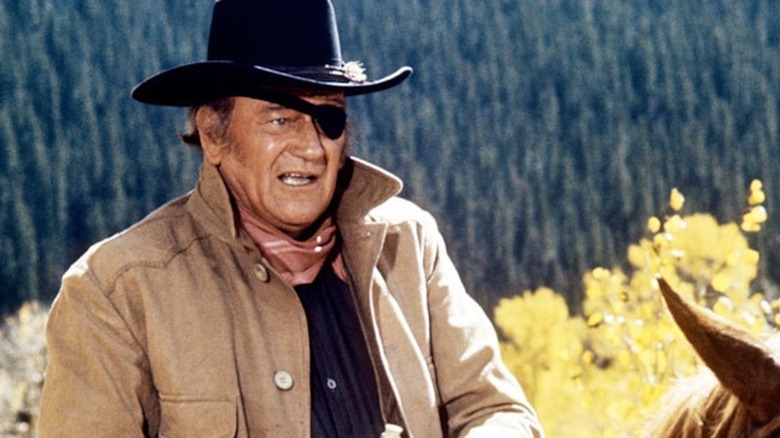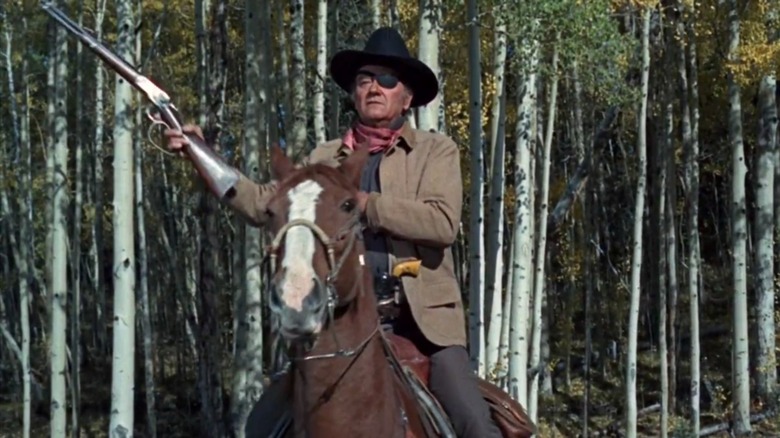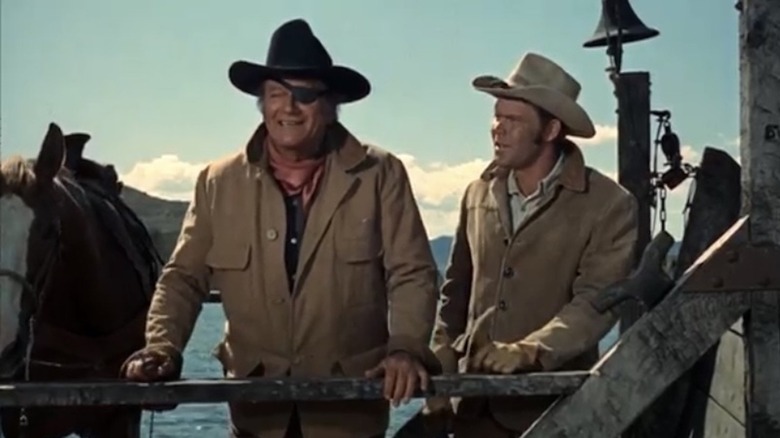John Wayne Wasn't Going To Let A Stuntman Be The Last Thing True Grit Audiences See
It's something of a cliche and a bit of a lie when actors say they do their own stunts. If you want to know what that really looks like, watch the end credits of any film Jackie Chan made in his Hong Kong prime. You'll see him break various extremities and get carried out on a stretcher more than once. The only Hollywood star with that kind of daredevil spirit working today is Tom Cruise, who seems determined to keep making Mission: Impossible movies well into his autumn years or die trying.
John Wayne was an ornery, prideful cuss who wanted to look like an authentic badass on the big screen, but he knew when to defer to his longtime stunt double Chuck Roberson (who recounted his perilous exploits in his immensely entertaining autobiography, "The Fall Guy: 30 Years as Duke's Double"). This was a practical matter as much as anything. If The Duke took a nasty spill, production could be shut down for months, which was anathema to the actor's thrifty filmmaking philosophy.
Still, Wayne's ego occasionally compelled him to take on stunts that could've easily been doubled. One such instance was the final shot of "True Grit."
The Duke takes flight
The Henry Hathaway-directed adaptation of Charles Portis' Western novel concludes with a scene at the Ross family plot, where a recovering Mattie (Kim Darby) parts ways with the hard-drinking U.S. Marshal Rooster Cogburn (John Wayne). As Cogburn rides off, he jumps a fence to prove to Mattie that he's not as out-to-pasture as she once claimed he was. It's a nifty final gesture that leaves the audience grinning, and, given its importance to the character, the 60-year-old Wayne insisted on performing the stunt.
According to Scott Eyman's biography "John Wayne: The Life and Legacy," the elevation of the Montrose, Colorado location was getting to the aging star. Nevertheless, he hopped on his horse and, per stuntman Gary Combs, did the damn thing:
"It's not an easy thing for an actor to do, to ride a jumping horse. But [stuntman Chuck] Hayward took his old sorrel horse Twinkletoes, and we made a low jump and we set the camera low and Duke ran the horse down there and jumped over the thing which was probably about two feet high. It was a nice jump ... He was game for anything."
An impressive stunt aided by a bit of camera trickery
While John Wayne did indeed do a jump, the low-angle shot described by Combs cuts to a decidedly higher jump once The Duke's horse goes airborne. But could the vast majority of the public execute a one-armed jump of two feet while waving a cowboy hat in the air? Absolutely not.
Had the sequence gone completely haywire, Wayne's long-awaited Best Actor victory at the 1970 Academy Awards might've been posthumous. Though he never did anything quite this daring again, the star still performed some nice riding in Mark Rydell's "The Cowboys," and seemed to do a bit of driving in his 1974 "Dirty Harry" knockoff "McQ." Until Don Siegel's elegiac "The Shootist," Wayne kept up tough-guy appearances for as long as he could. He wasn't always convincing, but there's something poignant about the effort.


